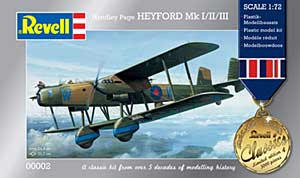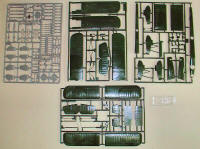
Revell/Matchbox 1/72 Heyford
| KIT: | Revell/Matchbox 1/72 Heyford |
| KIT #: | 04060 |
| PRICE: | $30.25 MSRP |
| DECALS: | Three options |
| REVIEWER: | John Doerr |
| NOTES: |

| HISTORY |
The Handley Page Heyford first flew in June 1930, in response an Air Ministry
specification for a new night heavy bomber.
One of the unusual design aspects was having the fuselage and engines
attached to the upper wing.
This feature gave the pilot and gunners a monoplane-like field of view
and fire.
Also included was a retractable “dust bin” ventral turret, aft of the wings.
The bomb bay was located in a thickened center section of the lower
wing.
Servicing method and locations were well thought out.
Fuel and oil filling locations were at “ground level” in the wheel
spats. The
servicing crews had no need to clamber over the aircraft during turnaround.
The bomb bays were designed so the bombs and racks were preloaded and
merely hoisted and plugged in.
Because of the engine locations the entire turn around could be
performed in a half-hour with the engines running.
One drawback of the layout was that the pilot sat 17 feet above ground
level and needed considerable practice with take offs and landings.
The Heyford was in front line service for a short period. It initially equipped 99 Squadron beginning in November 1933. By 1937 it was in service with 11 squadrons and beginning to be phased out in favor of monoplane bombers. The last Heyford was retired from active service in 1939 and subsequently declared obsolete.
| THE KIT |
 The
Revell-Germany 1/72 Heyford kit is labeled as a Revell Classic.
Actually it is a repop of a Matchbox classic, complete down to the multi
colored trees, in this case two, green and gray.
It is from the original molds and contains all the good, bad and ugly of
the original. It comes in a,
hooray!, lid and tray type box. I
do hope the folks over there are finally getting the message about boxes.
The kit contains 149 pieces.
The molding was crisp except for some minor flash around the smaller pieces on
the gray sprue. They have raised
details and the rib detail of the wings is the same generic type of years ago.
The
Revell-Germany 1/72 Heyford kit is labeled as a Revell Classic.
Actually it is a repop of a Matchbox classic, complete down to the multi
colored trees, in this case two, green and gray.
It is from the original molds and contains all the good, bad and ugly of
the original. It comes in a,
hooray!, lid and tray type box. I
do hope the folks over there are finally getting the message about boxes.
The kit contains 149 pieces.
The molding was crisp except for some minor flash around the smaller pieces on
the gray sprue. They have raised
details and the rib detail of the wings is the same generic type of years ago.
Most of us but the very young have built Matchbox
kits and understand the level of quality here.
The kit contains four figures, two pilots and two gunners.
There is no gunner for the ventral “dust bin” turret.
The details are rudimentary with no framing or detail on the interior of
the fuselage, which incidentally is split horizontally into top and bottom
halves, with two vertically split halves for the lower forward fuselage. The
cockpit consists of a generic instrument panel, two control wheels and a generic
type seat, while the second pilot sits in a tab on the inside of the fuselage.
Clearly there could be some improvement in the level of detail, that an
ambitious scratch builder could undertake
The kit includes the appropriate parts to build
all three marks. The difference
being a more powerful engine in the Mk II with two two-blade props installed to
make an impromptu four bladed prop.
The Mk III uses the same engine and prop but is supercharged.
The Mk II and III also used different chin coolers and exhausts.
More about this subject further on.
The Instructions
The instructions are exactly what one would
expect if they have built any Revell-Germany Models.
I might add the quality of the paper has improved somewhat.
Gone is the gray almost newspaper quality sheets and it is now close to
being white. The instructions
appear to be a reprint of the original Matchbox instructions.
They are in the international pictograph type drawings, which in places
are somewhat vague. Remember me saying that I would get back to the differences
in the Marks? You will find it in
the engine section. Not included
are the exhausts for a proper Mk II/III, the addition of the second two-bladed
prop and appropriate chin scoop is about as clear as Yogi Berra could say it.
Also not stated is the Mk IA was a Mk I with the “four bladed” prop.
It seems a little research and study would be a pre requisite before
building. The paints are letter
coded to the unique Revell brand names.
It seems an artist’s eye and research would be in line to get the colors
right, not to mention the fact that the
 many of the
colors in the instructions seem to be selected via the random dart throwing
method. At least the profiles
included seem to reasonably accurate, at least in their choice of colors
many of the
colors in the instructions seem to be selected via the random dart throwing
method. At least the profiles
included seem to reasonably accurate, at least in their choice of colors
Decals
The decals appear to be of decent quality. You get a selection of three aircraft from three different squadrons, one earth and dark green and the other two overall green, which agrees with profiles I have seen
| CONCLUSIONS |
This is not what I would rate as a must have
model. The faults are many but a
very AMS afflicted masochist could build this kit into a stunning model.
If you have been looking for Heyford, or are like me, addicted to
strange, weird and “different” aircraft then it’s the only game in town.
I would rate it as “Be afraid, Be very Afraid”
Model courtesy my penchant for, shall we say,
“unusual” aircraft
| REFERENCES |
http://en.wikipedia.org/wiki/Handley_Page_Heyford
http://www.handleypage.com/Aircraft_hp38_and_hp50.html
http://www.aviation-history.com/handleypage/heyford.htm
Thanks to my partner, Susan Csaba, Jim Marriott,
Peter O. Johnson and Chris Clifford who reviewed and helped.